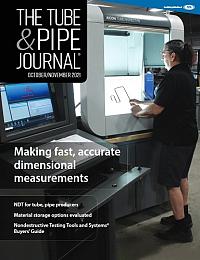Business Development Manager
- FMA
- The Fabricator
- FABTECH
- Canadian Metalworking
Categories
- Additive Manufacturing
- Aluminum Welding
- Arc Welding
- Assembly and Joining
- Automation and Robotics
- Bending and Forming
- Consumables
- Cutting and Weld Prep
- Electric Vehicles
- En Español
- Finishing
- Hydroforming
- Laser Cutting
- Laser Welding
- Machining
- Manufacturing Software
- Materials Handling
- Metals/Materials
- Oxyfuel Cutting
- Plasma Cutting
- Power Tools
- Punching and Other Holemaking
- Roll Forming
- Safety
- Sawing
- Shearing
- Shop Management
- Testing and Measuring
- Tube and Pipe Fabrication
- Tube and Pipe Production
- Waterjet Cutting
Industry Directory
Webcasts
Podcasts
FAB 40
Advertise
Subscribe
Account Login
Search
Choosing an NDT process for tube, pipe production
Augmenting an end-of-process inspection with online flaw detection
- By Phil Meinczinger and William Hoffmann
- Updated September 24, 2021
- September 28, 2021
- Article
- Tube and Pipe Production
As market pressures compel tube and pipe manufacturers to search for ways to increase productivity while maintaining adherence to strict quality standards, choosing the optimal inspection method and support system are more critical than ever. While many tube and pipe producers rely on a final inspection, in many cases manufacturers use a test further upstream in the manufacturing process to detect defective material or processes as early as possible. This not only reduces scrap but also reduces the costs associated with processing defective material. This approach ultimately translates to higher profitability. For these reasons, adding a nondestructive testing (NDT) system to the mill makes good economic sense.
Many factors—material type, diameter, wall thickness, process speed, and tube welding or forming method—determine the best test. These factors also influence the choices of features in the inspection method used.
Eddy Current
Eddy current testing (ET) is used for many tube and pipe applications. This is a relatively low-cost test that can be used on light-wall tubing applications, generally with wall thicknesses up to 0.250 in. It works on both magnetic and nonmagnetic materials.
The sensors, or test coils, fall into two basic categories: encircling and tangent. Encircling coils inspect the entire cross section of the tube, while tangent coils inspect the weld zone only.
Encircling coils detect flaws in the entire incoming strip, not just the weld zone, and they tend to be more efficient when testing sizes smaller than 2 in. dia. They also are tolerant of weld zone wander. A chief disadvantage is that threading the incoming strip through the mill requires an extra step, and extra care, to thread it through the test coil. Also, if the test coil is a close fit for the diameter, a failed weld can allow the tube to spring open and thereby damage the test coil.
Tangent coils inspect a small part of the tube’s circumference. On large-diameter applications, using a tangent coil rather than an encircling coil usually results in a better signal-to-noise ratio (a measure of the test signal’s strength relative to the static in the background). Tangent coils also require no threading and are calibrated more easily off the mill. The disadvantage is that they inspect the weld zone only. Suitable for large-diameter tubes, they can work for small sizes if the position of the weld seam is well-controlled.
Either coil type can test for intermittent discontinuities. A flaw test, otherwise known as a null or differential test, constantly compares the weld seam to adjacent sections of parent material and is sensitive to small changes caused by discontinuities. Suitable for detecting short defects such as pinholes or skip welds, this is the primary method used on most mill applications.
A second test, the absolute method, finds lengthy flaws. This simplest form of ET requires the operator to balance the system, electronically, on good material. In addition to finding gross, continuous changes, it also detects changes in wall thickness.
Employing both ET methods doesn’t have to be especially cumbersome. They can be used simultaneously with a single test coil if the instrument is equipped to do so.
Finally, the physical location of the tester is critical. Characteristics such as ambient temperature and mill vibrations—which are transmitted to the tube—influence the placement. Placing the test coil close to the weld box makes information about the weld process available to the operator immediately. However, temperature-tolerant sensors or additional cooling devices may be needed. Locating the test coil close to the end of the mill lets it detect flaws introduced by the sizing or shaping passes; however, false alarms are more likely because this location puts the sensor closer to the cutoff system where it is more likely to detect vibrations from the sawing or shearing processes.
Ultrasonic
Ultrasonic testing (UT) uses pulses of electrical energy and converts them to high-frequency sound energy. These sound waves are transmitted through a medium such as water or mill coolant to the material under test. The sound is directional; the orientation of the transducer determines whether the system searches for flaws or measures the wall thickness. An array of transducers can create a profile of the weld zone. The UT method is not limited by tube wall thickness.
To use the UT process as a measurement tool, the operator orients the transducer so it is perpendicular the tube. The sound waves enter the OD to the tube, reflect off the ID, and return to the transducer. The system measures the time of flight—the time that elapses while the sound wave travels from the OD to the ID—and converts the time to a thickness measurement. Depending on the mill conditions, this setup can measure the wall thickness with a precision of ± 0.001 in.
To find material flaws, the operator orients the transducer at a pitched angle. The sound waves enter at the OD, propagate to the ID, reflect back to the OD, and travel along the wall in this manner. A weld discontinuity causes the sound wave to reflect; it takes the same path back to the transducer, which converts it back to electrical energy and creates a visual display that indicates the flaw’s location. The signal also passes through flaw gates, which either set off an alarm to notify the operator or trigger a paint system that marks the defect’s location.
UT systems can use either a single transducer (or several single-element transducers) or a phased array of transducers.
Conventional UT uses one or several single-element transducers. The number of transducers depends on the expected flaw length, the line speed, and other test requirements.
Phased-array UT uses several transducer elements in a single body. A control system steers the sound wave electronically, without repositioning the transducer elements, to scan the weld area. This system can carry out several activities, such as detecting flaws, measuring the wall thickness, and monitoring the weld zone for scarfing variations. These inspection and measurement modes can be carried out essentially simultaneously. Importantly, the phased-array method can tolerate some weld wander because the array can cover a larger area than the conventional fixed-position transducer.
Magnetic Flux Leakage
A third NDT method, magnetic flux leakage (MFL), is used for testing large-diameter, heavy-wall, magnetic grades of tube and pipe. It is well-suited to oil and gas applications.
MFL uses a strong direct-current magnetic field that passes through the tube or pipe wall. The strength of the field is near full saturation, or the point at which any increase in the magnetizing force doesn’t result in an appreciable increase in flux density. When the magnetic lines of force encounter a flaw in the material, the resultant distortion in the magnetic flux causes it to emanate or bubble from the surface.
A simple coil-wound probe passing through the magnetic field can detect such a bubble. As is the case for other applications of magnetic induction, the system needs relative motion between the material under test and the probe. This motion is achieved by rotating the magnet and probe assembly around the circumference of the tube or pipe. To increase the processing speed, such a setup uses additional probes (again, an array) or several arrays.
Rotating MFL units can detect either longitudinal or transverse defects. The difference is in the orientation of the magnetizing structure and the probe design. In both cases, signal filters handle the process of detecting the flaws and distinguishing between ID and OD locations.
MFL is similar to ET, and the two complement each other. ET is useful on wall thicknesses less than 0.250 in., while MFL is used for products with walls thicker than this.
One advantage of MFL over UT is its ability to detect flaws that are less-than-ideally oriented. For example, MFL can detect a spiral defect readily. Such obliquely oriented defects, while possible to detect with UT, require a setup that specifically targets the expected angle.
Interested in more information on this topic? The Fabricators & Manufacturers Association (FMA) has more. The authors, Phil Meinczinger and William Hoffmann, will provide a full day of information and instruction on the principles of these processes, equipment options, setup, and use. The session takes place on Nov. 10 at the FMA headquarters in Elgin, Ill. (near Chicago). Registration is open for virtual and in-person attendance. Learn more.
About the Authors
About the Publication
Related Companies
subscribe now

The Tube and Pipe Journal became the first magazine dedicated to serving the metal tube and pipe industry in 1990. Today, it remains the only North American publication devoted to this industry, and it has become the most trusted source of information for tube and pipe professionals.
start your free subscription- Stay connected from anywhere

Easily access valuable industry resources now with full access to the digital edition of The Fabricator.

Easily access valuable industry resources now with full access to the digital edition of The Welder.

Easily access valuable industry resources now with full access to the digital edition of The Tube and Pipe Journal.
- Podcasting
- Podcast:
- The Fabricator Podcast
- Published:
- 04/16/2024
- Running Time:
- 63:29
In this episode of The Fabricator Podcast, Caleb Chamberlain, co-founder and CEO of OSH Cut, discusses his company’s...
- Trending Articles
Zekelman Industries to invest $120 million in Arkansas expansion

3D laser tube cutting system available in 3, 4, or 5 kW

Corrosion-inhibiting coating can be peeled off after use

Brushless copper tubing cutter adjusts to ODs up to 2-1/8 in.

HGG Profiling Equipment names area sales manager

- Industry Events
16th Annual Safety Conference
- April 30 - May 1, 2024
- Elgin,
Pipe and Tube Conference
- May 21 - 22, 2024
- Omaha, NE
World-Class Roll Forming Workshop
- June 5 - 6, 2024
- Louisville, KY
Advanced Laser Application Workshop
- June 25 - 27, 2024
- Novi, MI



























